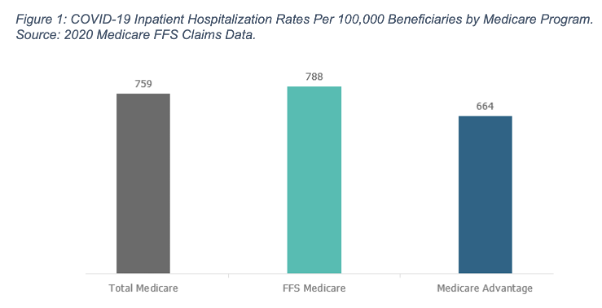Study Shows Lower COVID-19 Hospitalization, Mortality Rates in Medicare Advantage Than FFS Medicare
Findings show Medicare Advantage also outpaces FFS Medicare on access to non-COVID routine care among dual-eligible beneficiaries

Washington, D.C. – A new data brief commissioned by Better Medicare Alliance, the leading research and advocacy organization supporting Medicare Advantage, finds that Medicare Advantage had a 19% lower rate of COVID-19 related hospitalizations during the first nine months of the pandemic than fee-for-service (FFS) Medicare.
The study, conducted by ATI Advisory and based on fall 2020 Medicare Current Beneficiary Survey (MBCS) data, found that Medicare Advantage saw 664 COVID-19 hospitalizations per 100,000 beneficiaries, as compared to 788 COVID-19 hospitalizations in FFS Medicare.
The FFS Medicare population also experienced a higher mortality rate than Medicare Advantage. 22% of FFS Medicare beneficiaries hospitalized with COVID-19 died during their hospitalization, compared with 15% of Medicare Advantage beneficiaries hospitalized with COVID-19.
“When COVID-19 struck, Medicare Advantage was ready – delivering compassionate, coordinated care and proactive beneficiary engagement that resulted in fewer hospitalizations and lower mortality rates than FFS Medicare,” said Mary Beth Donahue, President and CEO of the Better Medicare Alliance. “What’s more, this study shows that Medicare Advantage outperformed FFS Medicare in access to non-COVID related care among dual-eligible beneficiaries, who are among the most at-risk members of the Medicare population. This includes regular check-ups, urgent care, and treatment for ongoing conditions. While COVID-19 exposed shortcomings in many areas of health care, these findings tell a powerful story of how Medicare Advantage met the moment and saved human lives.”
“COVID-19 illuminated opportunities for policymakers to lean in, learn, and improve our health care system, said Allison Rizer, Principal and Lead Researcher of ATI Advisory. “This analysis adds to that dialogue by showing that some of the most vulnerable individuals during the pandemic may have fared better in Medicare Advantage than those in Medicare FFS. We found higher rates of access to care and lower rates of COVID-related hospitalizations among Medicare Advantage enrollees. Policymakers should explore what can be learned from Medicare Advantage as they work to improve the Medicare program more broadly.”
Read the full data brief here. Key findings are summarized below:
- COVID-19 hospitalizations: Medicare Advantage saw 664 COVID-19 hospitalizations per 100,000 beneficiaries as compared to 788 COVID-19 hospitalizations in FFS Medicare, a difference of roughly 19%.
- Medicare Advantage beneficiaries comprised 40% of the Medicare population during the studied timeframe and 36% of all Medicare beneficiaries hospitalized with COVID-19. By comparison, FFS Medicare beneficiaries comprised 60% of the Medicare population and 64% of hospitalizations.
- COVID-19 mortality: 15% of Medicare Advantage beneficiaries hospitalized with COVID-19 died during their hospitalization, as compared to 22% of FFS Medicare beneficiaries.
- This is despite similar average ages of FFS Medicare and Medicare Advantage beneficiaries hospitalized with COVID-19. 50% of FFS Medicare beneficiaries hospitalized with COVID-19 were over 75 years old compared to 57% of Medicare Advantage beneficiaries.
- Access to care during COVID-19 (overall): Medicare Advantage and FFS Medicare beneficiaries reported the same likelihood of generally being able to access care during the pandemic. Medicare Advantage outperformed FFS Medicare, however, on certain types of care, including:
- Ability to get diagnostics: 73% in Medicare Advantage compared to 69% in FFS Medicare
- Ability to get dental care: 72% in Medicare Advantage compared to 66% in FFS Medicare
- Ability to get treatment for an ongoing condition: 70% in Medicare Advantage compared to 66% in FFS Medicare
- Access to care during COVID-19 among dual-eligible beneficiaries: Among beneficiaries dually eligible for Medicare and Medicaid, Medicare Advantage outpaced FFS Medicare on access to non-COVID-19 care, including:
- Ability to get urgent care: 92% in Medicare Advantage compared to 84% in FFS Medicare
- Ability to get diagnostics: 78% in Medicare Advantage, compared to 66% in FFS Medicare
- Ability to get treatment for an ongoing condition: 68% in Medicare Advantage compared to 63% in FFS Medicare
- Ability to get a regular check-up: 58% in Medicare Advantage compared to 43% in FFS Medicare
- Access to telehealth before and during the pandemic: Before the pandemic, 21% of Medicare Advantage beneficiaries reported access to telehealth services compared to 16% of FFS Medicare beneficiaries. During the pandemic, 50% of Medicare Advantage beneficiaries reported access to telehealth services, compared to 48% of FFS Medicare beneficiaries.
(*actual access to services may be higher, as these numbers reflect beneficiary knowledge of telehealth availability) - COVID-19 prevention behaviors among beneficiaries: Medicare Advantage beneficiaries were more likely to agree that COVID-19 was deadlier than the flu and were at least as likely to engage in behaviors to prevent infections. Among Black and Latinx beneficiaries, those enrolled in Medicare Advantage were more likely to practice higher numbers of preventive behaviors than those in FFS Medicare.
###
